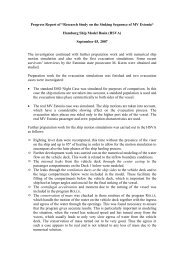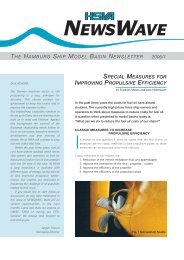You also want an ePaper? Increase the reach of your titles
YUMPU automatically turns print PDFs into web optimized ePapers that Google loves.
For the optimisation process two<br />
different strategies can be observed<br />
today. On the one hand most of the<br />
shipyards follow the strategy of increasing<br />
the block coefficient without<br />
increasing the resistance. On the other<br />
hand ship owners and a few shipyards<br />
investigate variants with lower block<br />
coefficient and therefore lower resistance,<br />
especially for vessels in a seaway.<br />
Having in mind the actual fuel prices<br />
which have almost doubled during the<br />
last years, this strategy may be more<br />
successful to cover future demands of<br />
ship owners and operators.<br />
The “QUICK CHECK” of the<br />
speed/power characteristics based on<br />
<strong>HSVA</strong>’s database can serve as input for<br />
a cash flow analysis comparing different<br />
design variants featuring different main<br />
parameters. The results of this analysis<br />
can be the basis on which decision makers<br />
can consider which variant shall be<br />
chosen for optimisation of the overall<br />
economy of a certain design.<br />
SERVICE SPEED<br />
AND SEA MARGIN<br />
This “QUICK CHECK” includes advise<br />
regarding a maximum economical<br />
speed for the customers vessel which<br />
should not be exceeded in service in<br />
order to avoid an excessive fuel consumption.<br />
This will help designers at<br />
shipyards and in design offices as well<br />
as decision makers at shipping companies<br />
when selecting main dimensions in<br />
an early stage of project development.<br />
Figure 2 illustrates that the economic<br />
speed of a project vessel (red line)<br />
can be expected to be in the range of<br />
FN between 0.225 and 0.255. The<br />
upper value can be achieved with well<br />
optimised lines.<br />
For service speed a sea margin of<br />
15% is often applied to the power,<br />
independent of the type and size of the<br />
vessel and any environmental and operational<br />
requirements. Having in mind<br />
the increasing fuel prices this simple<br />
procedure can no longer be recommended.<br />
Instead, the speed/power<br />
prognosis of a project vessel should<br />
2 <strong>NEWSWAVE</strong> 2006/2<br />
Fig. 2 Quick Check of the economic speed<br />
take into account the actual environmental<br />
conditions expected during<br />
normal operation.<br />
The “QUICK CHECK” of additional<br />
power demand which can be expected<br />
for actual environmental conditions<br />
(wind, sea state, restricted water) will<br />
give an indication if a charter contract<br />
based on 15% sea margin as service<br />
allowance will fall short, either in<br />
respect to the guaranteed speed or in<br />
respect to the guaranteed fuel consumption.<br />
PROPELLER DESIGN<br />
AND PRESSURE PULSES<br />
The “QUICK CHECK” of the propeller<br />
parameters, the tip speed, the power<br />
density and the pressure pulses to be<br />
expected for the actual design give an<br />
indication if the selected propeller in<br />
combination with the selected main<br />
parameters of the hull may face problems<br />
with respect to efficiency and cavitation<br />
induced pressure pulses.<br />
In this case the designer should consider<br />
not only using potential flow<br />
codes for optimising the hull, but also<br />
using more advanced numerical CFD<br />
tools for calculating the wake field and<br />
the expected pressure pulses for the<br />
actual design well in advance of model<br />
tests. Furthermore this check is helpful<br />
to decide upon the necessity of cavitation<br />
tests with the design propeller.<br />
INTERACTION OF SHIP<br />
AND PROPELLER<br />
Few shipyards spend time and money<br />
to improve the interaction between the<br />
ship, the propeller and the rudder.<br />
When the results of resistance and self<br />
propulsion tests are satisfactory (i.e. the<br />
target speed has been reached), the<br />
customer is often not willing to improve<br />
a wake field of average quality by further<br />
modifications to the aft body of the<br />
vessel. It is sometimes overseen that a<br />
wake field of good quality not only<br />
helps to reduce the pressure pulses of<br />
the propeller, thus minimising the danger<br />
of propeller induced vibrations in<br />
the structure, it is also the basis for<br />
reducing frictional losses of the propeller<br />
by allowing selection of the lowest<br />
area ratio Ae/Ao possible.<br />
The “QUICK CHECK” of the quality<br />
of the wake field based on <strong>HSVA</strong>’s database<br />
will give an indication whether<br />
further improvements of the wake field<br />
can be expected.





